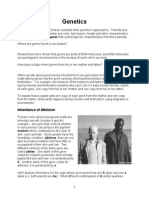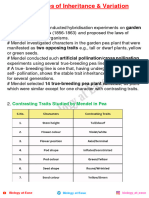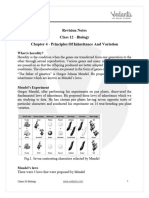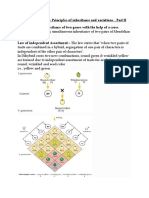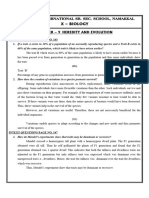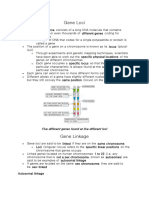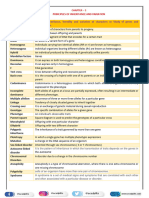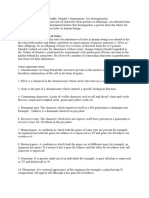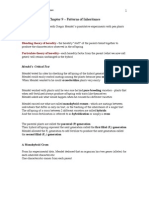0 ratings0% found this document useful (0 votes)
449 viewsGenetics Baby Lab Conclusion
Genetics Baby Lab Conclusion
Uploaded by
api-269480689There are three main ways that sexual reproduction produces variety in offspring: 1) crossing-over during meiosis exchanges random alleles between chromosomes, 2) independent assortment randomly determines which maternal and paternal chromosomes come together during fertilization, and 3) the random fusion of one egg and one sperm during fertilization leads to many potential combinations. Additionally, patterns of inheritance like Mendelian dominance, incomplete dominance, polygenic traits, and sex determination influence the expression of traits in offspring.
Copyright:
© All Rights Reserved
Available Formats
Download as DOCX, PDF, TXT or read online from Scribd
Genetics Baby Lab Conclusion
Genetics Baby Lab Conclusion
Uploaded by
api-2694806890 ratings0% found this document useful (0 votes)
449 views1 pageThere are three main ways that sexual reproduction produces variety in offspring: 1) crossing-over during meiosis exchanges random alleles between chromosomes, 2) independent assortment randomly determines which maternal and paternal chromosomes come together during fertilization, and 3) the random fusion of one egg and one sperm during fertilization leads to many potential combinations. Additionally, patterns of inheritance like Mendelian dominance, incomplete dominance, polygenic traits, and sex determination influence the expression of traits in offspring.
Original Title
genetics baby lab conclusion
Copyright
© © All Rights Reserved
Available Formats
DOCX, PDF, TXT or read online from Scribd
Share this document
Did you find this document useful?
Is this content inappropriate?
There are three main ways that sexual reproduction produces variety in offspring: 1) crossing-over during meiosis exchanges random alleles between chromosomes, 2) independent assortment randomly determines which maternal and paternal chromosomes come together during fertilization, and 3) the random fusion of one egg and one sperm during fertilization leads to many potential combinations. Additionally, patterns of inheritance like Mendelian dominance, incomplete dominance, polygenic traits, and sex determination influence the expression of traits in offspring.
Copyright:
© All Rights Reserved
Available Formats
Download as DOCX, PDF, TXT or read online from Scribd
Download as docx, pdf, or txt
0 ratings0% found this document useful (0 votes)
449 views1 pageGenetics Baby Lab Conclusion
Genetics Baby Lab Conclusion
Uploaded by
api-269480689There are three main ways that sexual reproduction produces variety in offspring: 1) crossing-over during meiosis exchanges random alleles between chromosomes, 2) independent assortment randomly determines which maternal and paternal chromosomes come together during fertilization, and 3) the random fusion of one egg and one sperm during fertilization leads to many potential combinations. Additionally, patterns of inheritance like Mendelian dominance, incomplete dominance, polygenic traits, and sex determination influence the expression of traits in offspring.
Copyright:
© All Rights Reserved
Available Formats
Download as DOCX, PDF, TXT or read online from Scribd
Download as docx, pdf, or txt
You are on page 1of 1
Sabrina Lam
Period 2
Advanced Bio
Genetics Baby Lab Conclusion
Sexual reproduction produces variety in offspring by three different ways. The three
ways are by crossing-over, independent assortment and fertilization. Crossing-over is when
random alleles are exchanged when aligning in the middle during meiosis. When exchanged, the
allele (gene) is traded for another allele. Alleles have traits in them which can change the
outcome of offspring.
During Metaphase I, the chromosomes align in the middle. However, where the
chromosomes go is completely random. This is what we call independent assortment. The pairs
can be put in whatever order.
The last way to produce variety is fertilization. There are many possibilities in
fertilization. Fertilization is caused by a random egg and a random sperm. There are many
possible eggs and sperm to already make variety in a baby. However with one egg and one sperm,
there are already four possible outcomes by using a punnett square.
There are also different patterns of inheritance as well. The different patterns of
inheritance are the Mendelian dominance, incomplete dominance, polygenic traits, and sex
determination. The Mendelian dominance states that recessive alleles will always be masked by
dominant alleles. An example of this from our lab is the widows peak. If you get Ww, the
phenotype would be a rounded shape because the W was dominant. I had ww so I had a straight
hairline.
Incomplete dominance is when one allele doesnt completely dominate another allele.
This results in the two alleles being blended. An example of this from our lab is the nose length.
If you get Ll, you will end up with a medium sized nose.
Polygenic traits display a continuous distribution (height, color). The inheritance of
polygenic traits doesnt show the phenotypic ratios like that of the Mendelian dominance, though
each of the genes contributing to the trait is inherited. It is basically when there are several types
of gene pairs that could go with one trait. An example of this from our lab is hair color. There are
many gene pairs that you can use for one trait.
Sex determination is done with two sex chromosomes: XX and XY. All eggs contain one
X chromosome while sperm may contain either an X or a Y chromosome. Depending on which
chromosomes each parent gives will determine the babys gender. If the father gives an X
chromosome, the offspring would be a girl. If the father gives a Y chromosome, the offspring
would be a boy. An example of this from our lab is the coin flip which we used the sides of the
coin to represent X and Y.
You might also like
- Multiple Choice Questions On Occupational Health and Safety (S. K. HALDAR) (Z-Library)Document440 pagesMultiple Choice Questions On Occupational Health and Safety (S. K. HALDAR) (Z-Library)gabriel castilloNo ratings yet
- Medical Surgical Nursing - IIDocument56 pagesMedical Surgical Nursing - IIGuruKPO50% (8)
- Biol 1700 - Assignment 2Document16 pagesBiol 1700 - Assignment 2api-456450673100% (1)
- Baby LabDocument1 pageBaby Labapi-270975269No ratings yet
- Genetic BabyDocument1 pageGenetic Babyapi-269496067No ratings yet
- Genetics: Inheritance of AlbinismDocument13 pagesGenetics: Inheritance of AlbinismAnonymous Ra09vhgL0% (1)
- BabygenlabDocument2 pagesBabygenlabapi-269077649No ratings yet
- Genetic Variation QuestionsDocument3 pagesGenetic Variation QuestionsAnna BuiNo ratings yet
- X Heredity and Evolution QaDocument2 pagesX Heredity and Evolution QaShrey PatelNo ratings yet
- 1234567890-Biology Chapter Principles of Inheritance and Variation Class 12 Notes (1)Document10 pages1234567890-Biology Chapter Principles of Inheritance and Variation Class 12 Notes (1)toni68839No ratings yet
- Principles of Inheritance & Variation NOTESDocument12 pagesPrinciples of Inheritance & Variation NOTESbdjdhdjshsjjNo ratings yet
- ConclusionDocument1 pageConclusionapi-248140910No ratings yet
- Class 12 Biology Chapter 5 Revision NotesDocument9 pagesClass 12 Biology Chapter 5 Revision NotesAnkur YadavNo ratings yet
- Biology Chapter Principles of Inheritance and Variation Class 12 Notes - ConvertedDocument9 pagesBiology Chapter Principles of Inheritance and Variation Class 12 Notes - Convertedtoni68839No ratings yet
- When Gender MattersDocument3 pagesWhen Gender MattersEduard PadillaNo ratings yet
- Outline: The Chromosomal Basis of InheritanceDocument4 pagesOutline: The Chromosomal Basis of InheritanceGizem OsmanogluNo ratings yet
- Chapter 3 by Group 1 in PSY 104Document63 pagesChapter 3 by Group 1 in PSY 104Joyce GarciaNo ratings yet
- Unit 3a - Prenatal PeriodDocument13 pagesUnit 3a - Prenatal Periodiamsathya2005No ratings yet
- UNIT-4-AND-5Document15 pagesUNIT-4-AND-5binadaal5No ratings yet
- Notes of HeredityDocument2 pagesNotes of Hereditygayathris111No ratings yet
- Chapter 5 Notes Part IIDocument11 pagesChapter 5 Notes Part IIRida ShareefNo ratings yet
- CLASS X NOTES CH-9 HeredityDocument5 pagesCLASS X NOTES CH-9 HeredityTurani SinghNo ratings yet
- CBSE Class 10 Science Notes Chapter 9 Heredity and EvolutionDocument20 pagesCBSE Class 10 Science Notes Chapter 9 Heredity and Evolutiondrphysics256No ratings yet
- Non-Mendelian GeneticsDocument32 pagesNon-Mendelian Geneticsnorminaepad2No ratings yet
- X-Cbsebiology (Heredity - Chap - 9) 1Document5 pagesX-Cbsebiology (Heredity - Chap - 9) 1selvisenthil1382No ratings yet
- Recombination and LinkageDocument11 pagesRecombination and LinkageHezel DulayNo ratings yet
- The Scientific Self: Zygote FertilizationDocument6 pagesThe Scientific Self: Zygote FertilizationWalang PangalanNo ratings yet
- Quantitative Characters InheritDocument5 pagesQuantitative Characters InheritHassaan MunawarNo ratings yet
- ReproductionDocument24 pagesReproduction김동후No ratings yet
- MeiosisDocument13 pagesMeiosisRianna Jane SanchezNo ratings yet
- Heredity and evolution, sample questions 3Document2 pagesHeredity and evolution, sample questions 3abhirajsingh.bkpNo ratings yet
- Chromosomes and Genes Chromosomal Abnormalities Multiple Births What Is Heredity? Principles of Heredity Hereditary CharacteristicsDocument16 pagesChromosomes and Genes Chromosomal Abnormalities Multiple Births What Is Heredity? Principles of Heredity Hereditary CharacteristicsChristian Almeria100% (1)
- Q. & A. Chap 05Document14 pagesQ. & A. Chap 05umamahfarooq75No ratings yet
- LinkageDocument8 pagesLinkagecdipesh01No ratings yet
- Genetics Unit Study NotesDocument6 pagesGenetics Unit Study NotesSandra TiffinNo ratings yet
- Self NotesDocument12 pagesSelf NotestungashindjombaNo ratings yet
- Heredity and EvolutionDocument4 pagesHeredity and EvolutionKumar AbhishantNo ratings yet
- CBSE Class 10 Science Chapter 9 NCERT Solutions 2022 - Free PDFDocument15 pagesCBSE Class 10 Science Chapter 9 NCERT Solutions 2022 - Free PDFMuzafar ahmadNo ratings yet
- Adobe Scan 11 Jul 2024Document5 pagesAdobe Scan 11 Jul 2024sundaramsharmaj7No ratings yet
- Meiosis Answered Review SP 08Document9 pagesMeiosis Answered Review SP 08RavindraNo ratings yet
- Chapter - 9 Heredity and Evolution Key PointsDocument6 pagesChapter - 9 Heredity and Evolution Key PointsNishal ThomasNo ratings yet
- #2 Non-Mendelian Patterns of InheritanceDocument24 pages#2 Non-Mendelian Patterns of InheritanceSunny AmarNo ratings yet
- Class-10 Subject - Biology: Question Answers of Heredity and EvolutionDocument6 pagesClass-10 Subject - Biology: Question Answers of Heredity and EvolutionNikunj Nipun GoelNo ratings yet
- CH-9 HeredityDocument10 pagesCH-9 Hereditysahakrish2023No ratings yet
- Chapter-5 Principles of Inheritance and VariationDocument9 pagesChapter-5 Principles of Inheritance and VariationbpmbhamoraNo ratings yet
- Genetics and HeredityDocument25 pagesGenetics and HeredityMariam HishamNo ratings yet
- Heredity and Inherited TraitsDocument5 pagesHeredity and Inherited TraitsblehblehdadaNo ratings yet
- CHAPTER 8 -HEREDITY _e2de904f-1acd-4787-bb7d-ef17f7a40013Document4 pagesCHAPTER 8 -HEREDITY _e2de904f-1acd-4787-bb7d-ef17f7a40013bm1356951No ratings yet
- a02ebeacbd2100f00e0b0d788ed0507cDocument7 pagesa02ebeacbd2100f00e0b0d788ed0507cSamridhi PundirNo ratings yet
- Mendelian and Non - Mendelian and Patterns of InheritenceDocument8 pagesMendelian and Non - Mendelian and Patterns of InheritenceBalolot RalphNo ratings yet
- 9 InheritanceDocument6 pages9 InheritancePeter TingNo ratings yet
- CBSE Class 10 Science Notes Chapter 9 Heredity and EvolutionDocument18 pagesCBSE Class 10 Science Notes Chapter 9 Heredity and EvolutionHarsh AgarwalNo ratings yet
- VariationDocument4 pagesVariationkealebogasaboroleNo ratings yet
- Chapter 5, The Chromosomal Basis of Inheritance (1)Document37 pagesChapter 5, The Chromosomal Basis of Inheritance (1)safaaabomallouhNo ratings yet
- ScienceDocument15 pagesScienceapi-276104079No ratings yet
- Chapter 4 AssignmentDocument2 pagesChapter 4 Assignmentlspennica2023No ratings yet
- Non-Mendelian Patterns of Inheritance IntroductionDocument39 pagesNon-Mendelian Patterns of Inheritance IntroductionErica NatividadNo ratings yet
- 9 InheritanceDocument6 pages9 InheritanceTalita KumalaNo ratings yet
- Concept and Types of LinkageDocument14 pagesConcept and Types of Linkagebhagirathsiwakoti2009No ratings yet
- LP Q1. Science9 w4Document7 pagesLP Q1. Science9 w4Christy BetitaNo ratings yet
- Anatomy and Physiology: Human Genetics: Things You Should Know (Questions and Answers)From EverandAnatomy and Physiology: Human Genetics: Things You Should Know (Questions and Answers)No ratings yet
- Sex Ed Uncensored - Sexual Identity: Mind Blowing Sex Sh8t!!! for Young AdultsFrom EverandSex Ed Uncensored - Sexual Identity: Mind Blowing Sex Sh8t!!! for Young AdultsNo ratings yet
- Report ViewerDocument4 pagesReport ViewerAsad PrinceNo ratings yet
- Zend Avesta 02 English Gustav Theodor FechnerDocument336 pagesZend Avesta 02 English Gustav Theodor Fechnergabriel brias buendiaNo ratings yet
- Ancel Keys - Atherosclerosis: A Problem in Newer Public HealthDocument22 pagesAncel Keys - Atherosclerosis: A Problem in Newer Public Healthacolpo100% (1)
- Biochemistry Control SerumDocument2 pagesBiochemistry Control SerumjarrelveeNo ratings yet
- Sir You Dont Know Your Wife Chapter 1038 1039Document6 pagesSir You Dont Know Your Wife Chapter 1038 1039Inna inspirazioneNo ratings yet
- Extrinsic and Intrinsic Factors in The Etiology of MalocclusionDocument7 pagesExtrinsic and Intrinsic Factors in The Etiology of MalocclusionNavroop KaurNo ratings yet
- Observing MitosisDocument14 pagesObserving MitosisMuhammad Marsaid Bin KardiNo ratings yet
- How It Works - Human BodyDocument180 pagesHow It Works - Human BodyMargo Sun95% (42)
- Cambridge O Level: Biology 5090/12Document20 pagesCambridge O Level: Biology 5090/12Sasaki MeraNo ratings yet
- Insulin: Pancreatic Hormones and Antidiabetic DrugsDocument5 pagesInsulin: Pancreatic Hormones and Antidiabetic DrugsEric James ManuelNo ratings yet
- Sexual Reproduction: Male Reproductive SystemDocument10 pagesSexual Reproduction: Male Reproductive SystemcyprianNo ratings yet
- Biomechanics of SpineDocument9 pagesBiomechanics of SpineAdosotoNo ratings yet
- Walt Whitman Poems and AssignmentDocument4 pagesWalt Whitman Poems and AssignmentRicky FlanneryNo ratings yet
- Accu Chek Guide Manual enDocument132 pagesAccu Chek Guide Manual enAlex XanderNo ratings yet
- Physiology - II (2nd Semester, Practical Short Notes)Document10 pagesPhysiology - II (2nd Semester, Practical Short Notes)Musfira KhalidNo ratings yet
- NCP 1 Team 1Document7 pagesNCP 1 Team 1janalthea.dautilNo ratings yet
- Amyotrophic Lateral SclerosisDocument3 pagesAmyotrophic Lateral SclerosisJohnpeter EsporlasNo ratings yet
- Ks4 Bones Physical EducationDocument29 pagesKs4 Bones Physical EducationClaudia PinnaNo ratings yet
- NCPDocument3 pagesNCPWendy Escalante100% (1)
- Bio Progress 2 G9Document9 pagesBio Progress 2 G9Mahmod YaishNo ratings yet
- BRAIN ASYMETRY Exp Rev ProtDocument11 pagesBRAIN ASYMETRY Exp Rev ProtChristina MountakiNo ratings yet
- Solve Sheet-General Science-1 Set ADocument3 pagesSolve Sheet-General Science-1 Set AAhmad RonyNo ratings yet
- Concise DermatologyDocument279 pagesConcise DermatologyVivtor Silva100% (2)
- Cellular Totipotency: Submitted by Name:Shahil Alam SI:2016014365Document13 pagesCellular Totipotency: Submitted by Name:Shahil Alam SI:2016014365Shahil AlamNo ratings yet
- Humour ( ) : Nouns Noun-Noun CollocationsDocument1 pageHumour ( ) : Nouns Noun-Noun CollocationsmohamedNo ratings yet
- Performance Checklist in Breasts and Axillae Assessment Skill RationalizationDocument4 pagesPerformance Checklist in Breasts and Axillae Assessment Skill RationalizationTrina Joyce HemedezNo ratings yet
- Prepared & Presented By: Juris Justin M. ToveraDocument73 pagesPrepared & Presented By: Juris Justin M. ToveraDaniel P100% (1)





